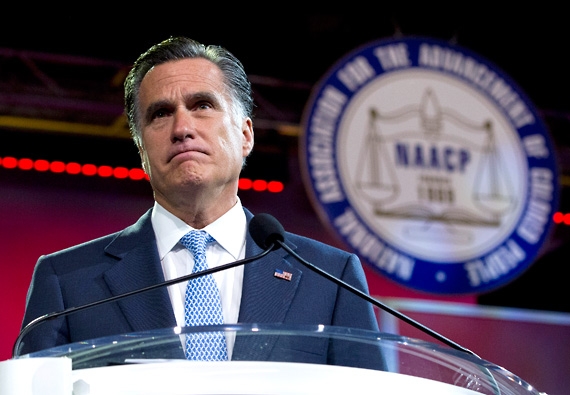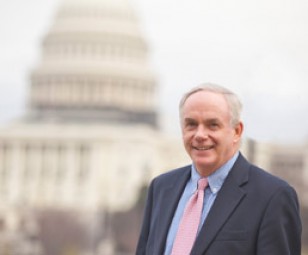Seeks to Avoid Palin Misstep of 2008

Republican presidential candidate, former Massachusetts Gov. Mitt Romney pauses during a speech to the NAACP annual convention in Houston, Texas. Photo: AP
Zero hour is approaching for the Romney campaign. Sometime soon, at the latest in a matter of a few weeks, the presumptive Republican presidential nominee will announce his choice of a vice presidential running mate. It’s always one of the most important decisions a presidential candidate can make.
Do it right, like John Kennedy did in 1960 when he asked rival Lyndon Johnson to join him on the Democratic ticket, and it can pay huge dividends. Kennedy eked out a victory over Republican Richard Nixon in large part because the addition of Johnson on the Democratic ticket helped him carry Johnson’s home state of Texas, a key in Kennedy’s win in the Electoral College.
But the Johnson pick is seen as the exception to the rule. The first rule of thumb most presidential nominees follow is ‘Do no harm.’ This would apply to Ronald Reagan’s choice of rival George H. W. Bush to join him on the 1980 Republican ticket and Bill Clinton’s somewhat unorthodox choice of Al Gore on the Democratic ticket in 1992. I say unorthodox because a young centrist southern Democrat picked another young centrist southern Democrat as his running mate, and this ended up playing well with voters across the country. I recall covering a Clinton-Gore bus trip up the Mississippi river in the summer of ’92 that became the political equivalent of rock stars cruising through the American heartland.
Sometimes the vice presidential pick can backfire and you don’t have to go too far back in time to find one of those examples. How about John McCain’s pick of Alaska governor Sarah Palin four years ago? The addition of Palin to the ticket initially excited conservative Republicans who were never gung-ho about McCain and offered Republicans a fresh face to rally around. The choice initially boosted McCain’s standing in the polls. But once Palin started doing news interviews the bloom came off the rose when questions mounted about whether she was ready for prime time. Still, other candidates have picked questionable running mates too, and survived. Richard Nixon’s choice of Spiro Agnew (Spiro who?) in 1968 didn’t really hurt him in a year when Americans were looking for change. George H.W. Bush’s surprise pick of little-known Senator Dan Quayle of Indiana in 1988 did not have much impact on his chances when he defeated Democrat Michael Dukakis by a comfortable margin.
The Contenders (We Think)
With all this in mind, here’s my quick rundown of Mitt Romney’s possible running mates, in descending order of likelihood.

Republican Senator, Rob Portman
Senator Rob Portman (Ohio). He’s experienced, by all accounts gets on well with Romney and could help deliver perhaps the number one state target in this year’s election: Ohio. On the negative side he’s dull, has ties to the George W. Bush administration and would do little to help Romney win over undecided women and Hispanics. Still, if the guiding principle this year is to avoid another Sarah Palin fiasco and pick an experienced person ready to be president on Day One, he’s probably at the top of the list.
Former governor Tim Pawlenty (Minnesota). Pawlenty reportedly has clicked with Romney better than anyone else, which is especially notable since they were rivals for the Republican nomination before he pulled out early in the race. Pawlenty appeals to suburban swing voters, a group he had to court to succeed in Democrat-leaning Minnesota, and his evangelical background would be a draw for Christian conservatives who may be lukewarm toward Romney. On the minus side, he did flame out of the presidential race rather early and at times seemed to back away from the kind of campaign attacks a running mate will have to carry out in a general election.

Louisiana Governor, Bobby Jindal
Governor Bobby Jindal (Louisiana). Wonky, smart on policy and tested as leader of a state that has had more than its share of natural disasters, Jindal would be an interesting pick. The son of immigrants from India, Jindal is a favorite among economic conservatives and is an articulate advocate of the Republican party’s smaller government dogma on the stump. But he got negative reviews for his 2009 nationally-televised response to President Obama’s State of the Union address and some Republicans still wonder how he would do in the national spotlight as Romney’s running mate.
Others mentioned but not as high on the list include former Florida governor Jeb Bush, who says he won’t take it, and New Jersey Governor Chris Christie. Christie may want it but some Republicans fear he might overshadow Romney. Florida Senator Marco Rubio remains in the mix and could help Romney carry a crucial battleground state in November. But there are questions about Rubio’s youth (he’s 41) and relatively little experience in the Senate, even though he excites conservatives and Tea Party followers. Wisconsin Congressman Paul Ryan is also in the mix, though his authorship of the polarizing House Republican budget plan may make him a little toxic in trying to win over moderates in November.
Then there is the third tier of possibilities especially favored by journalists compiling a list of people who probably don’t have a snowball’s chance in hell of being selected. But the Romney campaign likes it when they are mentioned as a sign of political courtesy and because it’s flattering to their supporters. They include New Hampshire Senator Kelly Ayotte, former Bush secretary of state Condoleezza Rice, New Mexico Governor Susana Martinez and even (gulp) New York entrepreneur Donald Trump. The longshots are even longer this year thanks to the long shadow of Sarah Palin from 2008 and because Mitt Romney, as both a politician and a businessman, has proven to be a cautious and calculating operator who carefully weighs risks and reward. Hence, the prediction here is a safe choice along the lines of Portman or Pawlenty.

